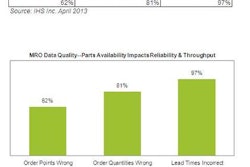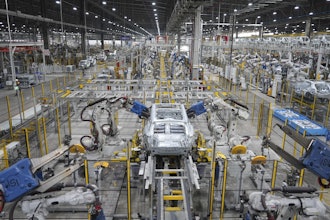Ecommerce solutions have to provide bottom-line results that coincide with the company’s business strategy. Customers have made it clear that they need savings and solutions provided from their suppliers to make their business processes efficient. If these value-added services are offered they are more willing to shop with them and not their competitors.
A valuable solution that distributors can offer their customers is the use of automated vending machines and tool cribs. This solution has been successful in creating benefits for both the distributor and the customer. According to Ralph Rio, research director for the supply chain consulting firm ARC Advisory Group, this is an area that can yield to successful growth for the distributors. Ralph Rio estimates that less than one percent of the available market is using automated dispensing solutions.1
End users are always looking for value-added services from their current suppliers and this is one solution that yields cost savings for the distributor, too. The vending machines make employees accountable for the number of tools they are using on the shop floor, which in turn cuts down the inventory and lowers production costs. Inventory is controlled since only those employees who have access to the tools can dispense tools from the machines.
Reporting can also be generated from the machines stating the exact employees that dispensed tools, and how many tools were dispensed. The machines can also be linked to back-office software platforms which provide data on inventory levels and automatically generate orders. This technology has been a big growth driver for distributors. Once these machines are in place it is hard to get the distributor out of the building. It is important to note that the machines are not a one size fits all and they can be customized to the needs of the customer.
Some companies are seeing a 25 to 40% savings by utilizing the solution in efficiency, reduced product usage, and greater productivity.2 Any customer that uses a vending solution will see a reduction in the amount of waste by employees since their use will be reported in a timely fashion.
Before any company purchases machines or technology, they should do research on the benefits and conduct an internal audit on what cost savings can be realized based on current processes. There are many companies that build vending machines and provide software programs that can send data back to the corporate systems. This is a major purchase of technology solutions and one that is hard to remove from end-users grasp once in place. Any company that wants to implement this sort of solution should look to find a distributor who is knowledgable and who can provide support after implementation.3
Many companies are now using the intelligence of their suppliers to place orders for them and to relief the cost burden of processing any needed paperwork to them. In order for the solution to work both companies must make sure they have the IT infrastructure in place, and to have a mutual trust with one another.
The main reason that companies look into a VMI application is to improve efficiencies in the supply chain. Efficiencies in the supply chain are realized because the companies share information in one central database that can be seen in real-time by employees in multiple locations. The implementation of this application implies that the parties have trust in one another and are willing to share vital information like customer demand and stock levels by item. On the plus side, with all companies involved in communication, there can be no excuses for not meeting corporate performance metrics.4
In order for this solution to work, a few organizational requirements need to be met. The senior management team and all functional areas of the organization have to see results and be on board with the solution. The technology investment needed should coincide with the organizational business strategy. The IT team should be involved in discussions since they need to make sure that the infrastructure is in place to support the solution. This solution should only be implemented if the company is moving towards more electronic commerce, and not just because other companies have the solution in place.
The biggest advantage of this application is the ability for the supplier to place replenishment orders for the customer without having to get the purchase order approved.4 The supplier and customer see in real-time what the current demand is and what inventory levels are across multiple locations. This move takes the order approval step out of the supply chain. Orders are now sent and approved electronically, which means fewer employees are needed, which reduces payroll. Another advantage that companies are seeing is how to share information which allows them to become better partners. This partnership will allow the companies to take a closer look at their business processes, and their current supply chain. Other advantages gained from utilizing VMI include stocking fewer inventories in distribution, and gaining better service from key suppliers.5 If companies have a mutual respect for each other, employees can spend less time on operational issues such as fill rate and backorders. With more efficiency in the supply chain, resources could move to other positions or become more involved in strategic positions.4
Vendor managed inventory is a perfect tool to use if you are in the distribution channel and work closely with stocked manufacturers. Gordon Graham, a panelist on the National Association of Wholesale-Distributors, called for the concept of vendor managed inventory to revolutionize the distribution channel in 1996.5 If the tool is used correctly savings are said to be in the eight to ten percent range.
Both companies involved in a VMI agreement need to be clear up front and communicate to one another that they care about each other and want to learn about each other’s business. The tool - when used correctly - is a win for both companies since the manufacturer has accurate sales figures they can use to build the products, and the distributor needs fewer inventories knowing they will receive it using the JIT strategy. If a company can buy better, it can reduce costs and offer customers the best price in the market.
If companies want to stay competitive they need to invest in technologies that allow then to meet their needs in a global economy.
William Heimerle has held jobs in purchasing for a few companies across many industries and has seen the use of electronic technology increasing over the past few years. His positions have enabled him to see how the use of ecommerce platforms can save organizations time and money for suppliers and customers. He is currently pursuing an MBA from St. Joseph's College.
1. Perriello, B. (2008, August). Crib notes. Industrial Distribution, 97(8), 26. Retrieved from http://search.proquest.com//?accountid=28722
2. Jakus, M., & Proctor, L. (2013). Push that button. ISHN, 47(4), 38-39. Retrieved from ABI/INFORM Complete database. (Accession No. 1348851701)
3. Wilson, T. (2010, April). Innovate to save. Canadian Metalworking, 105(3), 49-50. Retrieved from http://search.proquest.com//?accountid=28722
4. Duchessi, P., & Chengalur-Smith, I. (2008, December). Enhancing business performance via vendor managed inventory applications.Communications of the ACM, 51(12), 121-127. doi:10.1145/.1409384
5. Burke, M. (1996, February). It’s time for vendor managed inventory.Industrial Distribution, 85(2), 90.






















